This article has been
cited by other articles in ScienceCentral.
Abstract
Inverted papilloma is a common, benign sinonasal tumor with a known high rate of recurrence. To prevent recurrences, complete excision of inverted papilloma is essential. In complete excision, especially, identifying the attachment site of the tumor and managing the site meticulously is important. In this study, we introduce two surgical methods for complete excision of inverted papilloma that can reduce the recurrence rate: the prelacrimal approach and the ‘origin site cauterization and drilling (painting and washing)’ approach.
Go to :

Keywords: Endoscopy, Inverted papilloma, Maxillary sinus neoplasms, Paranasal sinuses
Introduction
Inverted papilloma is one of the most common benign sinonasal tumors [
1]. Its incidence is between 0.2 and 1.5 cases per 100000 persons per year occupying 0.5%-4% of all sinonasal neoplasms [
2]. It is pathologically benign. However, inverted papilloma is treated as clinically malignant tumor because of several typical characteristics. The tumor easily invades surrounding tissues including the bone. It can also change to a malignant tumor like squamous cell carcinoma or synchronously appear with malignant tumors. Moreover, if surgical resection is not complete, recurrence rate range from 14%-25% [
2]. Since remnant tumor frequently leads to recurrence, regular surveillance is mandatory. Therefore, complete surgical excision is very important in primary surgery [
3,
4]. In the past until the mid-1990s, external approach such as Caldwell-Luc and maxillectomy was the gold standard however, medical devices such as drill, soft tissue shaver and electrocoagulator were developed and endoscopic sinus surgery became the most universal treatment in many countries [
5]. Considering the development of endoscopic sinus surgery, we would like to introduce a surgical method for inverted papilloma in maxillary sinus to reduce recurrence rate.
Go to :

Methods
Preoperative assessment
Before planning a surgery, inverted papilloma is generally diagnosed with endoscopic exam, imaging (CT, MRI), and biopsy. After diagnosis, if surgical excision is possible the extent of excision is planned using CT or MRI (
Fig. 1). Then, the approach is decided after the extent of the tumor is checked.
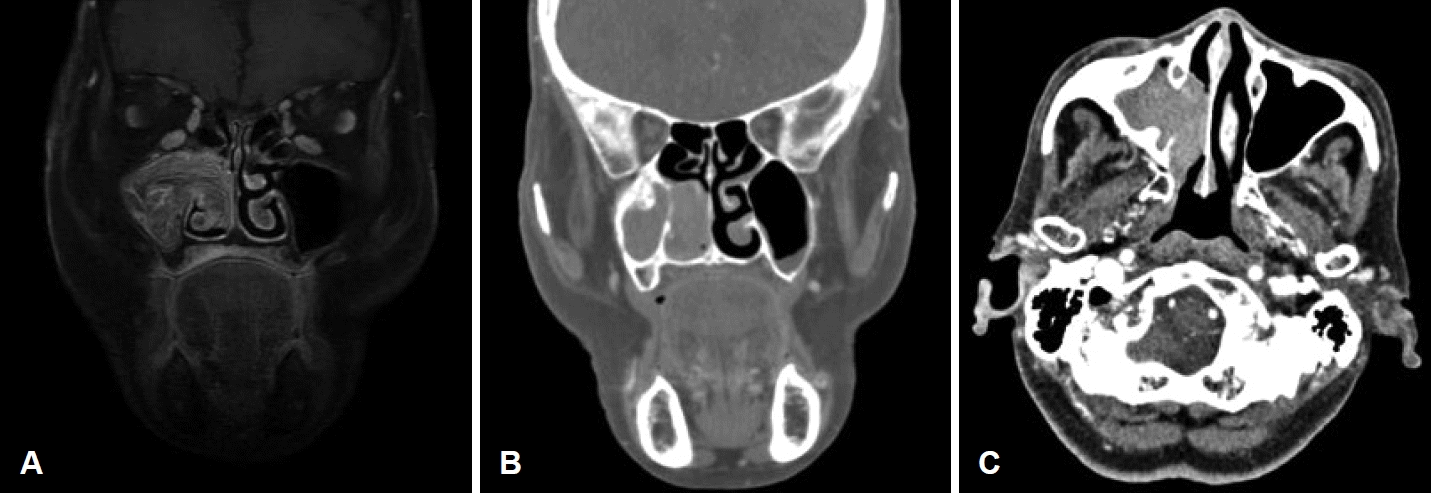 | Fig. 1.MRI and CT show a filling mass of the right side maxillary sinus. The superoposterior portion of the maxillary bony wall has bone thickening. Identification of osteitis in MRI and CT usually indicate the attachment site of inverted papilloma. In this case, this may be the suspicious attachment site of the inverted papilloma. A: Coronal T1W with fat suppression MRI scan showing right maxillary sinus mass with convoluted cerebriform pattern. B: Coronal view CT of right maxillary sinus mass with posterolateral wall bone thickening suggesting the origin site of the tumor. C: Axial view CT of right maxillary sinus mass with posterolateral wall bone thickening suggesting the origin site of the tumor. 
|
There are several clinical pearls of endoscopic sinus surgery for inverted papilloma. The most important point is the identification of the attachment site [
6]. If it is possible, en-bloc resection of the attachment site should be done with about a 1 cm margin. The National Comprehensive Cancer Network defines a clear margin as >5.0 mm. Considering shrinkage after formalin fixation, 1 cm margin is sufficient. Also, meticulous management of the origin site especially the underlying bone is very important. To be more certain, using frozen biopsy methods for negative margin confirmations is helpful.
Operative procedures
Prelacrimal approach (Figs. 2 and 3)
For complete resection of inverted papilloma especially in the maxillary sinus, nasolacrimal duct, inferior turbinate damage is sometimes unavoidable. This results in epiphora, incrustation, and abnormal nasal airflow after the operation which causes huge discomfort for patients. However, the intranasal endoscopic prelacrimal recess approach to the maxillary sinus provides a wide view and access towards inverted papilloma without nasolacrimal duct or inferior turbinate damage. Regarding the previous approaches like Caldwell Luc, middle meatal antrostomy, prelacrimal approach provides better access and fewer post-operative complications. Especially, it allows access of the maxillary sinus, including the prelacrimal, alveolar and palatine recess and the anterior wall of the maxillary sinus [
7]. Combining middle meatal antrostomy, every part of the maxillary sinus is accessible. Unlike the endoscopic Denker procedure, prelacrimal approach avoids the removal of the medial portion of anterior wall of the maxillary sinus. The main point of this approach is that inner cortical saucerization (red circle in
Fig. 2) using a drill allows adequate exposure without removing the whole bony wall structure like the Denker procedure (endoscopic Denker procedure is another approach for the anterior portion of maxillary sinus tumor which involves anterior maxillotomy without sublabial incision). Moreover, facial numbness occasionally occur due to injury of infraorbital nerve branches. The drilling of the bone or resection of soft tissue may lead to sensory deficits. However, numbness mostly recovers as time flows by. Comparing to modified endoscopic medial maxillectomy, prelacrimal approach shows lower risk for lacrimal pathway obstruction and empty nose syndrome. Also, epiphora risk and nasolacrimal duct stenosis may occur rarely [
8].
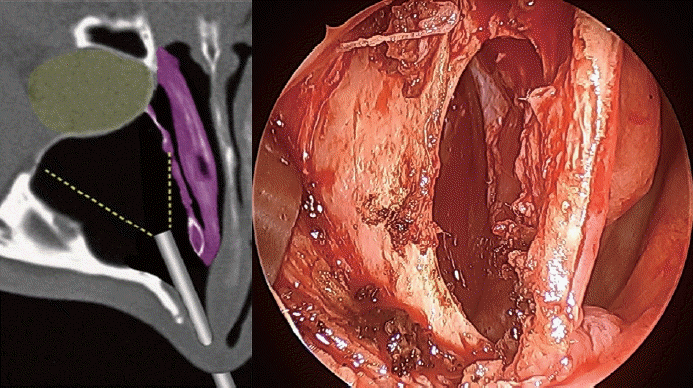 | Fig. 2.Right side prelacrimal approach to the maxillary sinus. Bony pyriform aperture is identified ( Supplementary Video. 1). 
|
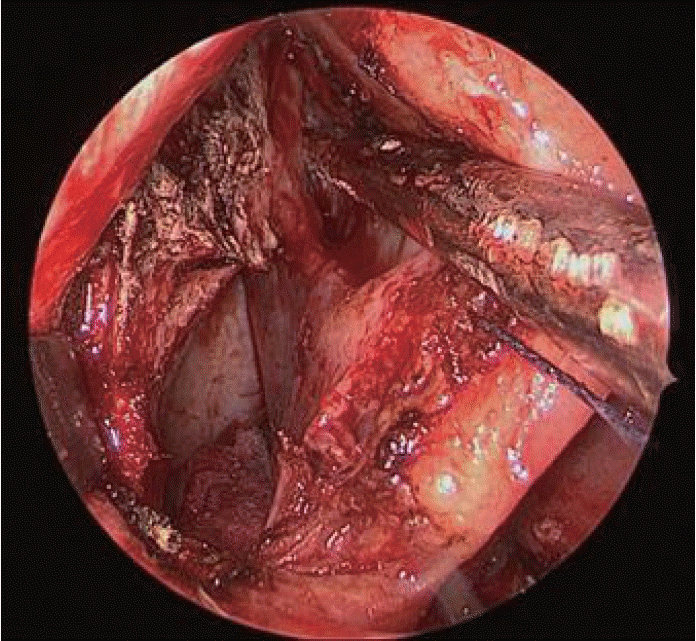 | Fig. 3.Prelacrimal approach with identification of nasolacrimal duct. 
|
Origin site cauterization and drilling (painting and washing)
After the mass is identified in the sinonasal cavity. Using an appropriate approach such as prelacrimal approach, debulking is done for sufficient exposure of the attachment site using devices like a soft tissue shaver. After identification of the attachment site, the margin is outlined with a 1 cm margin using bovie (painting) then, the underlying bone of tumor implantation point reaming is done with a drill (washing) in concerns of recurrence. Middle meatal antrostomy was also performed for easy surveillance in the future (
Figs. 4-
6).
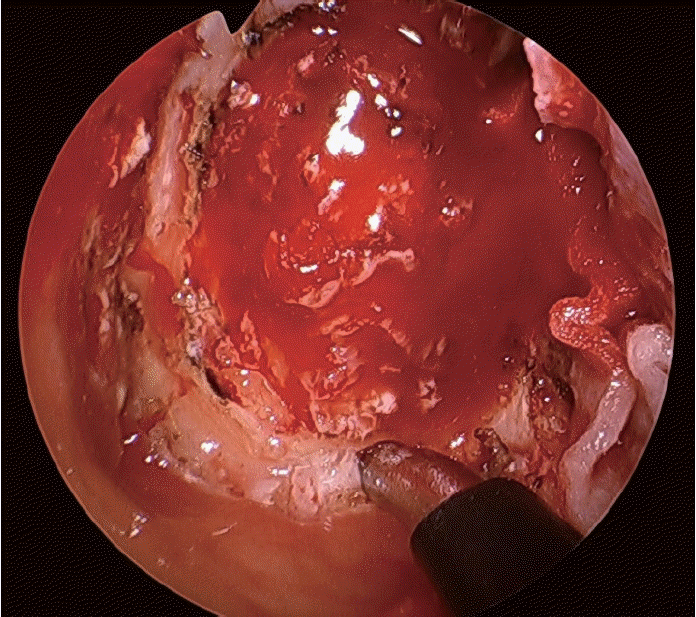 | Fig. 4.The attatchment site of tumor is ablated using coblator. 
|
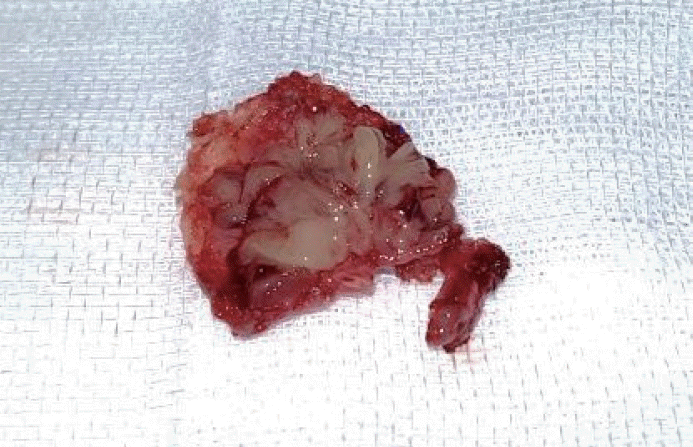 | Fig. 5.Enbloc resection of the attacthment site of tumor. 
|
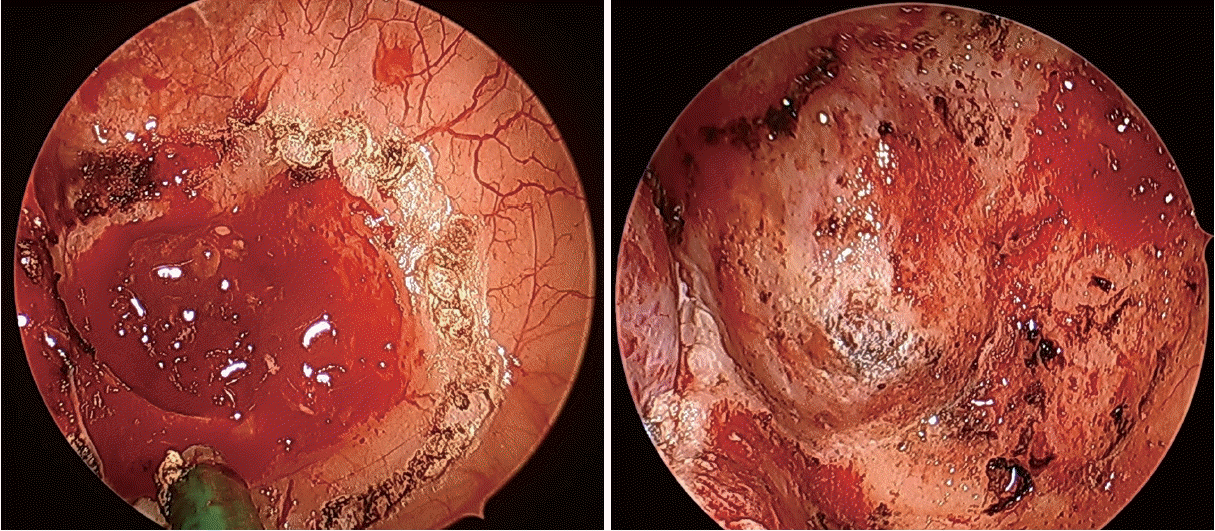 | Fig. 6.Bony attachment site is outlined with bovie (painting) which is later removed with high speed drill (washing) ( Supplementary Video. 1). 
|
Go to :

Results
The below case shows the whole procedure that used “prelacrimal approach” and “origin site cauterization and drilling (painting and washing)” method. A patient was diagnosed as the inverted papilloma with a suspicious attachment site of the superoposterior wall of the right maxillary sinus. Using the prelacrimal approach, endoscopic mass excision was completely done. After the operation, patient did not show any post-operative complications such as epiphora or facial numbness.
Go to :

Discussion
Regarding many approaches for inverted papilloma in maxillary sinus, prelacrimal approach shows better access and fewer post-operative complications like paresthesia, epiphora. Also, prelacrimal approach may expose nasolacrimal duct direct invasion in recurred tumors. However, since primary surgery in inverted papilloma is important to reduce recurrence, small risk for direct invasion of nasolacrimal duct is inevitable. For compensation of shortcomings of previous known approaches, other approaches such as modified endoscopic medial maxillectomy are also developing. Also, recently, minimally invasive surgery has become a new trend in all types of operations. Endoscopic sinus surgery was also developed as part of this trend. To continue minimally invasive surgery in the future, it should maintain similar results as external approach surgery. Thus, many surgical methods were devised for successful operation. Especially, in endoscopic sinus surgery many devices were developed as well as surgical methods. As we mentioned above, meticulous management of the attachment sites for inverted papilloma is important to reduce the recurrence rate. However, this method is not just limited to inverted papilloma, it can also be applied to any other tumor. Therefore, the prelacrimal approach and ‘origin site cauterization and drilling (painting and washing)’ can lead many external approach operations to endoscopic surgeries with no doubt for patients.
Go to :








 PDF
PDF Citation
Citation Print
Print







 XML Download
XML Download